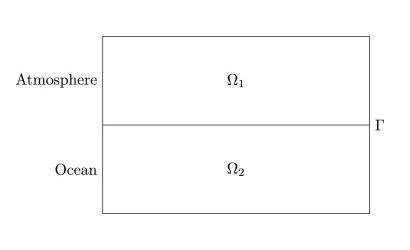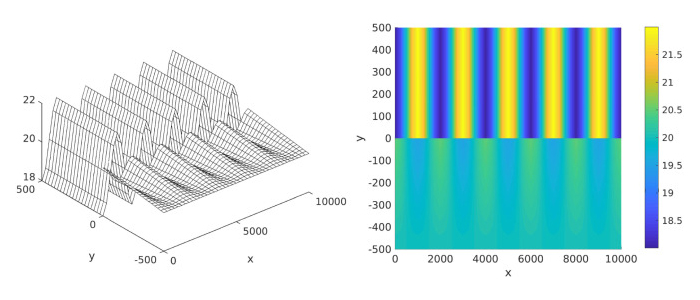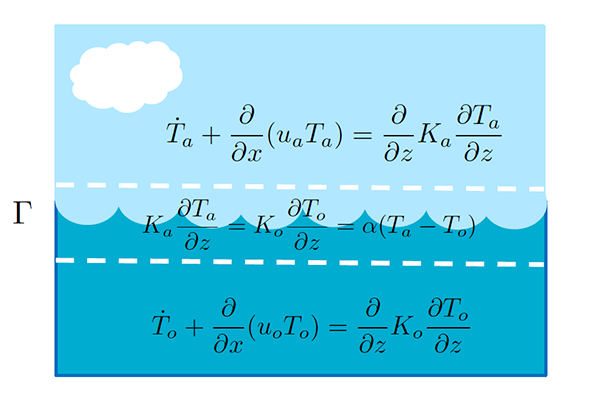Interface Flux Recovery Method for Ocean-Atmosphere Coupling
The Science
Efficient, accurate, and stable coupling schemes, or couplers, are essential for large scale predictive simulations of complex multiphysics phenomena such as the global earth system. Efficiency can be achieved by designing the coupler in such a way that each constituent component of the model can be discretized and solved independently from the other components. Most couplers accomplish this by lagging the coupling condition at the previous time-step, thus allowing each component to run autonomously in between coupling steps.
This so-called loosely coupled, or partitioned, methodology is minimally intrusive, which allows each component of the multi-physics models to be built, optimized, and evaluated separately from the other components. This approach effectively performs a single step of an iterative solution method for the monolithic coupled system, which may lead to instabilities and loss of accuracy. This process can be viewed as “agnostic” coupling that does not utilize the structure of the problem. A better coupling strategy is to use a “well-informed” technique that leverages the structure of the specific problem to approximate the interface flux between components. The “well-informed” strategy isolates the interface flux in the problem, allows for special treatment of this quantity to improve its approximation. Furthermore, this strategy preserves the partitioned structure of the problem, allowing each model to be solved separately and simultaneously.
The Impact
Traditional coupling schemes may develop instabilities and lead to unphysical simulation results. By using more accurate estimates of the interface flux, the proposed coupling approach avoids these pitfalls and increases the robustness of the coupled system simulations.
Summary

Figure 1. Ocean-atmosphere domain with the atmosphere subdomain (omega 1) on top and the ocean subdomain (omega 2) on the bottom. Capital gamma represents the interface between the ocean and atmosphere. For more details see Sockwell et al. (2020).
In this paper, scientists formulated an Interface-Flux-Recovery (IFR) coupling method which improved upon the conventional coupling techniques in climate models. IFR starts from a monolithic formulation of the coupled discrete problem. The monolithic system was then enriched by treating the interface flux condition as an auxiliary equation. This allowed for a separate treatment of the interface flux from each model. Researchers then isolated the flux via a Schur complement to obtain an accurate approximation of the flux across the interface between the model components. This decoupling allowed for independent solutions for each component using schemes that were optimized for each component, respectively. To demonstrate the feasibility of the method, scientists applied IFR to a simplified ocean-atmosphere model for heat-exchange coupled through the so-called bulk condition (Fig. 1), common in ocean-atmosphere systems. They then solved this model on matching and non-matching grids to estimate numerically the convergence rates of the IFR coupling scheme.
The IFR method was demonstrated on a simplified test case with an exact solution for the bulk condition. The test case consists of a wave in the horizontal direction with a discontinuity across the interface (Fig. 2). The discontinuity drives the flux across the interface in the bulk condition. Convergences tests were performed using the IFR method for different magnitudes of diffusion, which lead to different magnitudes in flux across the interface. The IFR method was also evaluated on non-matching grids for the two subdomains. In all cases, the expected convergence rates were achieved.

Figure 2. Surface (left) and density (right) plot of the initial condition of the solution at t = 0. The domain is given in meters and the solution is in degrees Celsius. See the Sockwell et al. (2020) paper for more details.
Publication
- Sockwell, K, K Peterson, P Kuberry, P Bochev, and N Trask. 2020. “Interface Flux Recovery Coupling Method for the Ocean–Atmosphere System.” Results in Applied Mathematics 8: 100110. https://doi.org/10.1016/j.rinam.2020.100110.
Funding
- The U.S. Department of Energy’s Office of Science funded this work under the Scientific Discovery through Advanced Computing (SciDAC) program and the Earth System Model Development (ESMD) program area, via the Coupling Approaches for Next-Generation Architectures (CANGA) project.
Contact
- Pavel Bochev, Sandia National Laboratory



